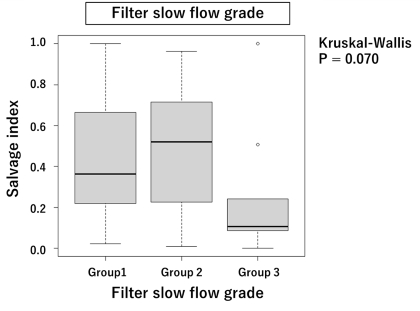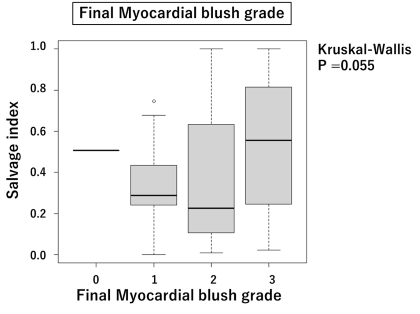Final ID: Sa4015
Catch me if you flow slow: The temporal filter slow flow fact
Abstract Body (Do not enter title and authors here): Background: Slow flow phenomenon is impaired coronary flow during percutaneous coronary intervention (PCI) in absence of mechanical obstruction, and it is associated with deteriorated outcome. Filter device may prevent final slow flow; however, the impact of slow flow phenomenon with an intra-coronary filter device for STEMI is unclear.
Objectives: We assessed the hypothesis that temporal filter slow flow (FSF) during procedures of reperfusion therapy end in Thrombolysis in Myocardial Infarction flow grade 3 (TIMI-3) in STEMI is not associated with myocardial infraction size, using cardiac magnetic resonance (CMR).
Methods: STEMI patients who underwent coronary revascularization therapy and cardiac magnetic resonance (CMR) at about 4 days and 6 months between 2017 and 2023 were included. The patients were divided into groups (Group 1, FSF (-) during procedures with final TIMI-3; Group 2, FSF (+) with TIMI-3; Group 3, final angiogram was non-TIMI-3). Myocardial salvage index was calculated with area at risk using acute phase T2 high volume and chronic phase late gadolinium enhancement volume.
Results: The age (Group 1 (n=31): median 70 y [interquartile range 43 -84] vs. Group 2 (n=23): 68 [35 - 81] vs. Group 3 (n=9): 72 [61 - 79], P = 0.386), prevalence of male (81% vs. 96% vs. 89%, P = 0.258), and door-to-balloon time (58 min [20 -218] vs. 65 [30 - 157], vs. 59 [25 - 111], P = 0.491) were similar between the groups. The relationship between salvage index and FSF was shown in figure1. The relationship between salvage index and myocardial blush grade was shown in figure 2. In the multivariate regressive analysis of the salvage index, chronic kidney disease (CKD), myocardial blush grade 3, door to balloon time and filter slow flow groups, CKD and myocardial blush grade 3 were found to be independently and significantly correlated.
Conclusions: Non-myocardial blush grade 3, as a part of slow flow observed in the final angiogram, is associated with impaired myocardial salvage. However, temporal filter slow flow may not diminish myocardial salvage.
Objectives: We assessed the hypothesis that temporal filter slow flow (FSF) during procedures of reperfusion therapy end in Thrombolysis in Myocardial Infarction flow grade 3 (TIMI-3) in STEMI is not associated with myocardial infraction size, using cardiac magnetic resonance (CMR).
Methods: STEMI patients who underwent coronary revascularization therapy and cardiac magnetic resonance (CMR) at about 4 days and 6 months between 2017 and 2023 were included. The patients were divided into groups (Group 1, FSF (-) during procedures with final TIMI-3; Group 2, FSF (+) with TIMI-3; Group 3, final angiogram was non-TIMI-3). Myocardial salvage index was calculated with area at risk using acute phase T2 high volume and chronic phase late gadolinium enhancement volume.
Results: The age (Group 1 (n=31): median 70 y [interquartile range 43 -84] vs. Group 2 (n=23): 68 [35 - 81] vs. Group 3 (n=9): 72 [61 - 79], P = 0.386), prevalence of male (81% vs. 96% vs. 89%, P = 0.258), and door-to-balloon time (58 min [20 -218] vs. 65 [30 - 157], vs. 59 [25 - 111], P = 0.491) were similar between the groups. The relationship between salvage index and FSF was shown in figure1. The relationship between salvage index and myocardial blush grade was shown in figure 2. In the multivariate regressive analysis of the salvage index, chronic kidney disease (CKD), myocardial blush grade 3, door to balloon time and filter slow flow groups, CKD and myocardial blush grade 3 were found to be independently and significantly correlated.
Conclusions: Non-myocardial blush grade 3, as a part of slow flow observed in the final angiogram, is associated with impaired myocardial salvage. However, temporal filter slow flow may not diminish myocardial salvage.
More abstracts on this topic:
A Unique STEMI Etiology: Paradoxical Coronary Embolism
Davis Thomas, Saado Jonathan, Kietrsunthorn Patrick, Williams Eric
Clinical Relevance of FFR-guided PCI According to Left Ventricular Systolic Function in Patients with Acute Myocardial Infarction and Multivessel DiseaseLee Yong-kyu, Hahn Joo-yong, Kim Hyun Kuk, Park Keun Ho, Choo Eun Ho, Kim Chan Joon, Ahn Gyun, Doh Joon-hyung, Lee Sang Yeub, Park Sang Don, Lee Hyun-jong, Lee Seung Hun, Kang Min Gyu, Nam Chang-wook, Choi Ki Hong, Park Taek Kyu, Yang Jeong Hoon, Song Young Bin, Choi Seung-hyuk, Kim Ju Han, Ahn Youngkeun, Jeong Myung Ho, Kim Hangyul, Gwon Hyeon-cheol, Koh Jin-sin, Hong Young Joon, Ahn Joon Ho, Cho Kyung Hoon, Kim Min Chul, Sim Doo Sun, Lee Joo Myung, Hong David


